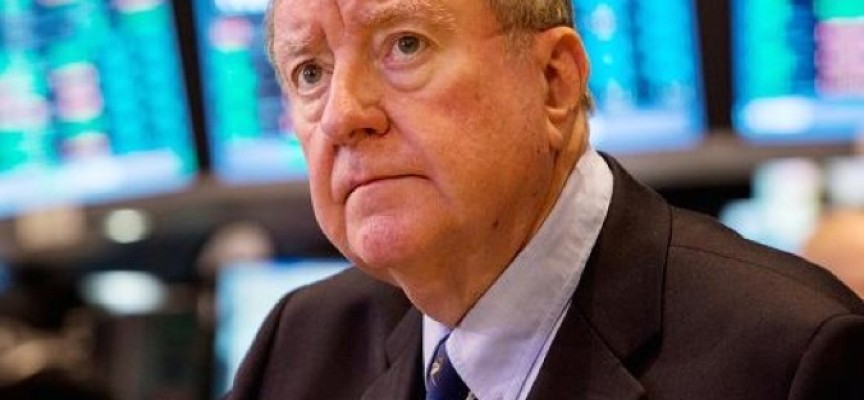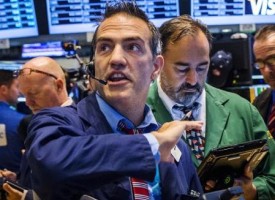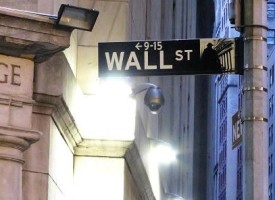A legend in the business, Art Cashin, who is Head of Floor Operations at UBS, just issued this October warning for the stock market.
September 14 (King World News) – Art Cashin, Head of Floor Operations at UBS: On this day in 1812, a very valuable piece of real estate committed suicide – – or at least that’s the way it seemed to the guy who had just acquired the property.
His name was Napoleon Bonaparte and the property in question was called Moscow, a metropolis of some cultural and governmental note in the Russian Empire. On this day, Nappy and his boys entered the city to find it virtually deserted by its nearly half million citizens.
As he set up headquarters in town, awaiting the surrender of Czar Alexander (and the Empire) his staff brought him reports of scattered building fires. Napoleon at first thought the fires were the result of his own troops carelessly looting abandoned buildings. He gave the order to shoot looters and put out the fires. But as soon as the fires were put out, the buildings (and others) were in flames again.
What the “Little Corporal” did not know was that the Czar’s generals had ordered all the prisoners’ dungeons be unlocked. And they promised freedom and land to any prisoner who stayed behind and set fires in the city. Soon 90% of Moscow was on fire, and Napoleon had to flee his headquarters through streets that one of his general’s said looked like “the entrance to HELL!”
The Czar’s boys liked the results so well that over the next three weeks they burned barns, stables and grain bins all around Napoleon. And, when the snows came, within a month, Nappy found himself with an army that was ill fed, ill clothed and ill-equipped. Thus one of history’s great military minds lost both a campaign and his army. (Of the 500,000 men Napoleon led toward Moscow only 30,000 survived to return home, a nearly 95% casualty rate.)
The Wall Street equity bulls could certainly empathize with Napoleon as they had felt somewhat smug and satisfied as the oversold bounce had taken them back into solid levels – above 4100 in the S&P and equally lucky spots in the Dow and the Nasdaq. At 8:30, when the CPI inflation data hit, it was as if a trapdoor opened, and equity futures went straight down, never flinching and continued to move in that direction right through the opening bell.
There were all manner of self-styled TV pundits wondering why the selloff was so sharp and how could this number mean this and that to the economy. How could this number mean this and that to Apple earnings? They completely missed the picture. What had happened was, at least according to widespread rumors, some of these short- term institutional traders, had staked out positions, thinking the number was going to be favorable and that they would get a rocket ride as shorts would be forced to cover.
I explained all that on TV and repeated it almost immediately thereafter in this late morning update:
Late Morning Update 09.13.22
As I just discussed with Carl Quintanilla and David Faber on CNBC Squawk on the Street, I think, the severity of the selloff was caused by a group of institutional short-term traders, who were rumored to go long in front of what they thought would be a favorable number and got caught off base with leveraged positions.
The opening selling was an absolute flush, but it has produced no attempt to circle the wagons and rebound and they erode still further. The S&P has broken below 4000, which is important and is presently trading at 3986. The 3975/3980 should provide some support (but obviously the critical test, unlikely today, would be down at 3900 and I mean critical).
The interview also took me through some discussions with Jonathan Stephens about the 1962 analog and appeared to be running about a week ahead of time and this oversold bounce has suddenly turned into an overbought condition, which they are purging rather heavily this morning. Normally these market swings take anywhere from 5 to 7 calendar days, but we do have, as I said on TV, the Autumnal Equinox coming up and that is a period that was important to the famous W.D. Gann and others. We will have to keep an eye open on any seasonality showing up, but for now, it may be best to go over some of this morning’s numbers.
As we go to press, they are retesting the 3980 area in the S&P. As noted above, the 3975/3980 area is assumed to provide some manner of support. There is no sign at all of the recently traditional move up as we go into the European close, which may mean that more of the selling is from Americans and less from Europeans.
Watch the yield on the ten-year, if it gets up and starts to test the 3.50% range, it could be a bit of an electric shock.
Stay nimble and stay safe.
Arthur
What was amazing about the selloff, was that they never really tried to circle the wagons. They did not keep plunging, but they did tick steadily, tick after tick down and, that is somewhat unusual when you get to down 3 or 4%. Usually, a few bargain hunters show up and try to circle the wagons. None of that happened and, while that support that we had suggested in the at S&P 3975/3980 managed to hold for all of maybe 30-minutes while it was being tested, that was as close to circling the wagons as they came and then we plunged right through it. They came exceedingly close to the assumed test of 3900 that we are going to see. Of course, if they break, the assumption is they then go down to 3815, which is, I believe, some important Fibonacci support (hat tip – Katie Stockton). While we are mentioning help from experts, we had a conversation with the astute Jonathan Stephens, who reminded me that he had, in fact, been the one suggesting an interim high on Monday based on the 1962 analogy that we noted in the late morning update.
We had a further conversations with another technical genius, Mark Newton of Fundstrat. Mark said the reversal of this oversold bounce, may, unfortunately, have legs on the downside. It is a possibility of the usual short multi-day selloff, but Mark who has an extremely sharp compass and protractor, suggests that it is some cycle work that looks to disturbing action possibly into October 6th and 7th. We had suggested, obviously, from the 1962 analogy, October could be a very, very volatile month and, if there are geopolitical analogous, it could be a painfully volatile month.
So, we will get out the slide rule and see where we go. That will make the next few days important. If we continue under pressure, the testing at 3900 will be, as we said, quite important and then down to that important Fibonacci number around 3815. As I said on TV, if we break that, as the ancient cartography used to say – beyond this line there be dragons.
We will continue to watch. Remember, the Fed is still in its quiet period. So, on the Fed, we strongly doubt that they would think about going to a full 100 bp only because, as much as Powell wants to appear strong and effective, they do not want to do anything to surprise the markets. It has not gone well in the past. I am betting big numbers on the 75 bp they announced, unless you find it leaked in some financial publication or another.
Okay. Let’s look at how our action affected global markets.
Overnight, Asian markets are smartly lower, but it is almost 100% in reaction to what happened in New York yesterday and kind of a catch-up game. It is a similar story in Europe, but the selling is not quite as aggressive as Asia. Asia has had to catch-up to the full selloff in New York whereas Europe participated in the first half and is now catching up to the afternoon portion of the selling.
The economic calendar is very light. We get the mortgage data and Producer Price Index and then, in late morning, we will get the Atlanta Fed inflation number, which will be carefully watched.
As we go to press, the U.S. futures are still higher, but have given up about half of their gains and people are cautious about what the next step may bring. In China, President Xi is scheduled to leave the country today for the first time in over 1000 days. He, ostensibly, is going to meet with Putin in Uzbekistan, but his first stop will be Kazakhstan and the interesting thing was the last time he landed in Kazakhstan, he launched the Belt and Road Initiative that China tried to push throughout most of the emerging world nations.
So, geopolitics may be the name of the game. The market is going to have to grapple with its own internal technicals and cocktail napkin charting suggests that the assumption that the huge selloff like yesterday is followed by a bounce back as bargain hunters come in is not really true in market history and, it happens, in fact, less than 50% of the time.
We will have to remain cautious and watch the technicals and, if they turn negative again, clearly watch that S&P 3900 level. That will be absolutely critical and watch the yield on the ten-year. If it goes above 3.46% that could bring pressure on stocks again.
The game is on the table. You know the drill. Stay close to the newsticker. Keep your seatbelt fastened. Stay nimble and alert and please stay safe.
Also of importance…
Rapidly Growing Royalty Portfolio
Ryan McIntyre: Maverix continues its successful track record of buying royalty portfolios from the some of the largest and most reputable mining companies in the world, as we just acquired a portfolio of 22 royalties from Barrick Gold. The acquisition increases our portfolio to a total of 147 royalties and streams and enhances our already robust exposure to the next generation of gold mines. The highlight of the portfolio is the 1% royalty on the Eskay Creek project in Canada that is expected to produce 350,000 gold equivalent ounces per year. Once in production this royalty alone will add 10% to our existing revenue base. Additionally, the portfolio boasts significant existing attributable mineral inventory with meaningful exploration potential in historic mining geographies.
Massive Growth Story
But more exciting than that, Eric, is the fact that Maverix already has royalties on a trio of notable gold projects expected to come online in the next few years. The first is the expansion that is underway at Karora Gold’s Beta Hunt mine in Australia that will add over 10% to revenue by 2024. The next is Agnico Eagle’s restart and potential expansion of its Hope Bay mine in Canada in 2025 that could see production increase at two to three times the original capacity and add 10% to the current revenue base. The third one is the 5% royalty we own on the Gemfield project in Nevada owned by Centerra Gold that could add approximately 20% to Maverix’s revenue starting in 2026.
Massive Upside Leverage
And, Eric, if people believe the metals are headed higher then Maverix will unquestionably benefit, as its 90% margins are inflation-protected and it has a significant and growing portfolio that will benefit from the higher prices…Maverix Metals, symbol MMX in Canada and the US.
***To listen to James Turk discuss the chaos in Europe and the US as well as how silver and gold could vault to new highs quickly CLICK HERE OR ON THE IMAGE BELOW.
***To listen to Alasdair Macleod discuss chaos he expects to see in the global markets as well as the big short squeeze he expects to take place in the gold and silver markets CLICK HERE OR ON THE IMAGE BELOW.
© 2022 by King World News®. All Rights Reserved. This material may not be published, broadcast, rewritten, or redistributed. However, linking directly to the articles is permitted and encouraged.









